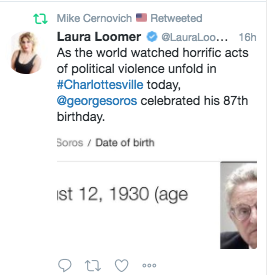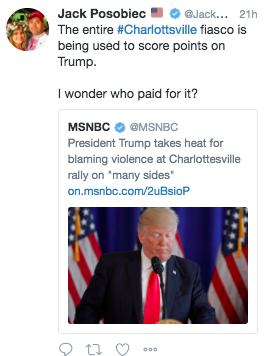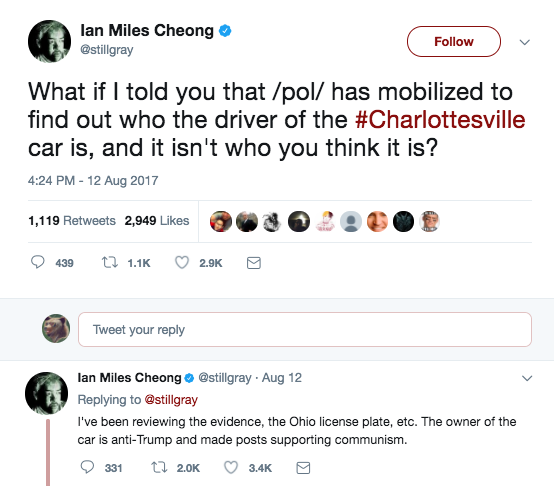
The events in Charlottesville have created the first real crisis for the pro-Trump media, which is caught between its mainstream aspirations and its addiction to the traffic and energy of the white nationalist movement.
For the better part of 2017, the collective of Twitter personalities, trolls turned citizen journalists, and social justice-hating memelords that make up the pro-Trump media has tried to distance itself from Trumpism’s more virulently white nationalist elements. Much of that work, though, has likely been undone in the aftermath of Saturday’s deadly Unite The Right demonstrations, during which a white nationalist plowed into a group of anti-racist protesters, killing one and injuring more than a dozen.
Across the internet after the violence, the pro-Trump media’s narrative — usually clear and concise — appeared scrambled. Prominent pro-Trump personalities took to Twitter to condemn the political violence and declare the alt-right to be vile Nazis. They excoriated the anti-fascist movement and the violent and intolerant left, and they bashed the media for its anti-Trump bias and inciting rhetoric that helped create a culture of political violence.
Taken together, the hundreds of tweets, posts, and Periscopes from the “new right” over the last few days have ranged from anxious to defensive to exhausted. But most of all, they reveal a movement that, much like Trump himself, finds itself isolated — trying desperately to dissociate from the convenient alliances it made in the campaign, and in danger of irreparably tarnishing its credibility.
Throughout the campaign, the alt-right was a large, amorphous group of disparate and overlapping factions — neo-Nazis and white nationalists; young, excited, digitally savvy Trump supporters; alienated and anxious white men; media-hating opportunists; and any number of trolls, from the nihilists to the anti-SJWs. It was a convenient alliance under the banner of a candidate who continually gave voice to previously taboo cultural views.
But once their man was in office, the fissures began to show almost immediately. When reports surfaced that attendees of a Richard Spencer-hosted conference had done Nazi salutes, the moderate factions of the alt-right condemned the behavior. Then, a falling out among organizers of the pro-Trump “DeploraBall” inauguration party led to self-proclaimed white nationalist Tim Gionet (Baked Alaska) getting kicked out as an event host. Personalities such as Mike Cernovich and Jack Posobiec began distancing themselves from the alt-right by dubbing themselves the new right, an inclusive, nonbigoted nationalist movement. By June, the split was complete, with the two groups holding competing rallies and slinging insults across Twitter.
But this new right is, at present, ill-defined. It exists instead as a sort of media and communications arm for Trumpism and its core tenets: destroying the mainstream media, winning for the sake of winning, and pissing off liberals. Rather than advocating explicit policies, the new right appears more concerned with constructing a playbook for a formidable digital insurgency: Identify the outrage, swarm it, make it go viral, create chaos, control the narrative. But in order to do this, the new right must appeal to a broad audience. The movement is caught between the mutually exclusive goals of denouncing alienating ideologies like white nationalism, and continuing to appeal to the very people who made it a movement in the first place.
In this way, the new right is much like Trump. Both value attention and prominence in the news cycle above all else. Both must — at all times — speak their minds. Both flirted during the campaign with covert racists, if only by their silence. And both won and now find themselves dogged by their past association, as the alt-right trades in its fashionable haircuts for honest-to-god torches and swastikas.
Politically, the tragedy in Charlottesville offered a rare opportunity for the new right to rise above partisanship. Had the movement simply condemned the attack and said little else, or called for momentary unity with its enemies in the media and on the left, the group could have set itself fully apart from the violence. But it, like the president, opted instead to have the last word and relitigate past arguments. Borrowing from Trump’s playbook, the new right chose to play the victim. It bemoaned the attack as a massive setback for its movement. It castigated the media for dividing the country and not reporting on the violence of the left. It used the method of attack as an attempt to rehash arguments about migrants and Islamic terror.
And, like Trump, it seemed unable to avoid dredging up conspiracy theories. Alex Jones of Infowars suggested the rally was “staged” to vilify the right and stop future conservative gatherings. Mike Cernovich tweeted at KKK leader David Duke, calling him “Deep State David” as a nod to clandestine government involvement in the protests. A handful tried to blame the entire event on their favorite enemy: George Soros.



Pro-Trump media sites like Gateway Pundit and Chuck Johnson’s GotNews pushed unconfirmed stories from 4chan identifying the Charlottesville driver as an “anti-Trump druggie.” Posobiec also broadcast the unconfirmed and quickly disproved theories. Ian Miles Cheong — a Daily Caller reporter — referred his 53,000-plus followers to 4chan’s /pol/ message board floating a similar conspiracy. “I've been reviewing the evidence, the Ohio license plate, etc. The owner of the car is anti-Trump and made posts supporting communism,” he tweeted.

Like Trump, the new right appears unable to quit the fever swamp. The pro-Trump media’s leaders, publications, and followers claim the moral high ground with their denouncements of political violence and the alt-right on one hand, while pandering to the most unseemly corners of the internet on the other. Much like the president, who appears unable to sever ties with his small but dedicated base, the new right appears unable to abandon the internet’s underbelly — a place where many pro-Trump media personalities cut their teeth, and which is still frequented by part of the new right's audience. Like Trump, they denounce racism but gesture toward communities like 4chan, where ironic racism is not just an in-joke but a rite of passage.
And so for now the isolation continues. On Tuesday morning, Infowars editor Paul Joseph Watson attempted to correct reports from outlets like CNN that labeled Posobiec as a member of the alt-right. For Watson — who nine months ago announced he was severing ties with the alt-right to be part of the group that “likes to wear maga hats, make memes, and have fun” — the constant distancing appears exhausting. “How many times do myself, @JackPosobiec & @Cernovich have to be attacked by the alt-right before the media stops calling us alt-right?” he tweeted.
And they aren't the only ones in this fix. Indeed, the main American figure caught halfway between the fringe and the mainstream, pleasing nobody, is the president of the United States.
Quelle: <a href="The Pro-Trump Media's Post-Charlottesville Identity Crisis“>BuzzFeed
Published by